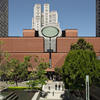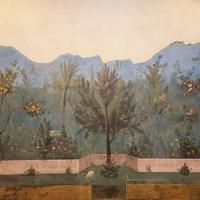More about The Kitchen Garden in the Eyot
- All
- Info
- Shop

Contributor
On February 15th, 2019, Gary Garrels and Janet Bishop of the SFMOMA acquired The Kitchen Garden on the Eyot by Leonora Carrington.
In an attempt to diversify SFMOMA's collection, the museum sold Mark Rothko's Untitled (1960), which it had acquired from the generosity of the great Peggy Guggenheim (ex-wife of Leonora Carrington's former flame, Max Ernst), at Sotheby's, the $50.1 million proceeds of which would allow it to buy eleven works, including this one. The SFMOMA has its own rule book for deaccessioning, including these restrictions: "The work cannot be created by a living artist; works by living artists are not to be sold except to acquire a superior work by the same artist, and then only with the agreement of the artist." The goal was not just to diversify the collection financially, but also to find works from women, non-European people, and other groups of artists underrepresented in the collection and in art history more broadly.
Carrington's lack of recognition in the canon of surrealist history, compared to artists like Salvador Dali or Rene Magritte, is in part due to the tendency of the circle to see women as inherently uncreative. In a Spanish-language interview (Carrington was a naturalized citizen of Mexico) the artist said that she liked the ideas of the surrealists, but Andre Bréton, the key theorist, and his friends were very macho ("muy machistas"). "They only wanted us as crazy, sensual muses to entertain and serve them." Also, she adds, "mi reloj no se detuvo en ese momento," a Spanish idiom which translates as "my watch didn't stop at that moment," meaning that Carrington wasn't discouraged by this macho environment, and was going to continue to make art no matter what those guys thought or said. "I only lived with Ernst three years. I don't like being boxed in like a fool."
By 1946, when she composed this painting, she was pregnant with her first son, Gabriel "Gaby" Weisz-Carrington, by the Hungarian Jewish photographer Emérico "Chiki" Weisz Schwarz. Both expatriates, Carrington and her husband remained married for sixty-one years. Carrington met Schwarz while she was living with Remedios Varo, with whom she often discussed the subjects of mysticism and alchemy. Carrington and Varo also studied the oral traditions of the Kʼicheʼ people, collected in a text called the Popol Vuh. In many ways, the K'iche' are the first surrealists, and the Popol Vuh gives us fantastic lines like this one: "Hushed and empty is the womb of the sky." The titular kitchen garden shown here, where food and nourishment are grown, can be seen as a metaphor for creation. The chickens and the symbol of the egg present throughout the work further suggest a theme of motherhood and fertility.
According to the great Carrington specialist Whitney Chadwick, in whose honor the SFMOMA acquired this work, The Kitchen Garden on the Eyot is one of several Carrington works which displays women pursuing the "Gran Trabajo alquímico," or the Great Work, which is the four-step process of Hermetic spiritual transmutation. The three figures to the left can be understood as Carrington, Varo, and their photographer friend Kati Horna, who "experimented with potions and explored obscure mythologies." Art historian Solomon Adler also suggests that this painting is a celebration of their womanhood, perhaps a retort to the narrow-minded sexism of their male surrealist counterparts in Europe. Countering Carrington's prescribed role as someone else's muse, Adler writes that in this work, "Her garden is walled off from external influence, as an independent space of creative action. That this garden is on an eyot—a river island—doubles this autonomy, twice placing the artist in her own world of miraculous conception."
Carrington was also influenced by Christian mythology, and especially the Quattrocento paintings of "satanic ghouls and saintly miracles," she encountered while studying art in Florence. According to Adler, "The Kitchen Garden on the Eyot borrows the extreme perspective, simplified figures, and small heads that made the work of the early Renaissance feel otherworldly, as if adjacent to reality." She also borrows her technique from early Christian art, using egg tempera on a wood panel (more eggs!).
After Carrington finished this work, it was acquired by the photographer and designer Sir Cecil Beaton, most famous for his costumes in My Fair Lady and for his portraits of Marilyn Monroe.
Sources
- Chadwick, Whitney. Leonora Carrington: la realidad de la imaginación. México, D.F.: Consejo Nacional para la Cultura y las Artes, Dirección General de Publicaciones, 1994.
- Cherem, Silvia. "Emerico Weisz, Fotógrafo, marido de Leonora Carrington, compañero de Robert Capa." Diario Judio, Jul. 18, 2014, https://diariojudio.com/comunidad-judia-mexico/emerico-weisz-fotografo-…
- Desmarais, Charles. "SFMOMA sold a Rothko for $50 million; this is what they bought with the proceeds." Datebook, 2019, https://datebook.sfchronicle.com/art-exhibits/sfmoma-sold-a-rothko-for-….
- Gatopardo, 41-44. Bogotá: Publicaciones Semana, 2003.
- Osberg, Annabel. "Exploring the Transmutative Power of Food and Painting in Leonora Carrington’s Spellbinding 'Kitchen Garden on the Eyot'." AEQAI, Apr. 25, 2020, http://aeqai.com/main/2020/04/exploring-the-transmutative-power-of-food…
- "SFMOMA Announces Deaccession to Benefit the Acquisitions Fund and Strategically Diversify the Collection." SFMOMA, Feb. 15, 2019, https://www.sfmoma.org/press-release/rothko-deaccession-2019/.
- Tate, Carolyn E. Reconsidering Olmec Visual Culture: The Unborn, Women, and Creation. Austin: University of Texas Press, 2012.
- "The Kitchen Garden on the Eyot." SFMOMA,https://www.sfmoma.org/artwork/2019.92/.
- Adler, Solomon. "Leonora Carrington, The Kitchen Garden on the Eyot, 1946." SFMOMA, December 2020 https://www.sfmoma.org/essay/leonora-carrington-the-kitchen-garden-on-t…














